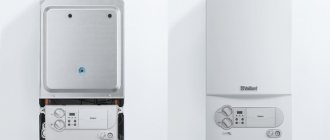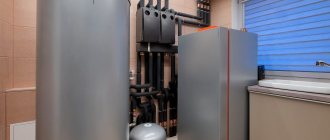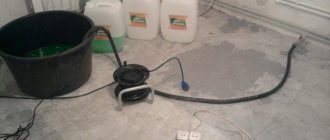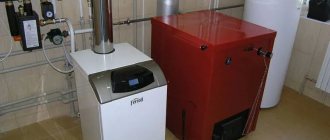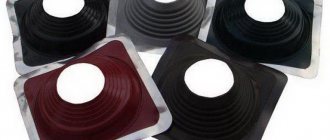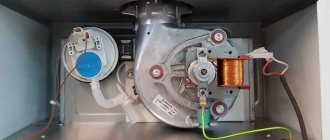Some simple models of electric boilers do not have smooth power adjustment, not to mention wider functionality. But even with degree-by-degree adjustment, the operation of the automation is based on measuring the temperature of the coolant in the supply and return of the boiler, which is not entirely effective: high accuracy cannot be achieved; high inertia is characteristic, i.e. a rather slow change in air temperature in the house.
But the main thing is that in the absence of precise adjustments, a lot of electricity is wasted.
The problem can be solved by installing a special room thermostat (thermostat) for an electric boiler, more expensive models of which measure the air temperature in the room and regulate the boiler operating mode in accordance with it, which is more correct and, most importantly, allows you to save from 10 to 50% of electricity. Moreover, the price of the issue is only 800-1000 rubles for simple mechanical models or 3-5 thousand rubles for more functional programmable thermostats controlled from a phone.
Electric boilers
A fairly common alternative to gas and solid fuel boilers. Lots of advantages, high efficiency, but long payback period. The connection is simple, like with gas boilers, but without a cold water supply. Temperature regulation and overheat protection are provided.
Mechanical boiler timer
Using a simple mechanical timer for an electric boiler, there are three options for starting the central heating system :
- The boiler is turned off;
- The boiler supplies warm water;
- The boiler turns on and off at the set time.
Mechanical timers usually have a large round dial with a 24-hour scale in the center. By turning the dial, you can set the desired time, and then leave it in that position. The boiler will turn on at the right time. The outer part consists of a set of tabs for a 15-minute period, which are inserted for easy adjustment of operation and mode settings. Emergency reconfiguration is possible, which is performed with the boiler connected to the network.
Mechanical timers are easy to set up, but the boiler always turns on and off at the same time every day, and this may not satisfy the owners if the family is large and bathing procedures are carried out several times a day at different times.
Weekly programmers Salus UK
The temperature regulator for electric boilers from Salus, model T105RF, is a wireless weekly programmer that allows you to set two temperature levels: “comfortable” and “economical” in the range of 7-30 0 C, in increments of 0.5 0 C.
For any day of the week, you can set one of 9 programs, 6 of which have hard factory settings, 3 of which can be set by users themselves. The device is equipped with a large informative display with blue backlight.
The programmer of this model can be used with any gas and electric heating units that have terminals for connecting a thermostat.
Attention! If several sets are connected at one facility, you can select one of 32 communication codes, which eliminates mutual negative influence of the equipment. If when choosing a thermostat its cost plays an important role, then you can choose a cheaper wired model
If cost plays an important role when choosing a thermostat, then you can choose a cheaper wired model.
Types of thermostats
Based on the type of functions, they can be divided into several groups:
– with one function (temperature maintenance);
Thermostat with one function
– with a large number of functions (programmable).
Programmable temperature controller
Based on their design, thermostats are divided into types: wireless and with wires for communication with the boiler. Install the thermostats in a convenient place, connect the temperature sensor, connect it to the boiler control system and use it.
Room thermostats need a constant flow of air to function properly and properly, so they should not be covered with curtains or blocked by furniture. Devices adjacent to the electric thermostat may interfere with the correct operation of the device: lamps, televisions, heating devices located nearby.
Programmable room thermostat
A programmable electronic room thermostat allows you to select the desired and comfortable temperature at any time; it is easy to reconfigure and change the operating mode. The timer allows you to set a different heating pattern on weekdays and weekends. Some timers allow you to set different settings for each day of the week, which can be useful for people who work part-time or shift work. Many Terneo and KChM models are equipped with such thermostats.
Programmable room thermostat
A programmable room thermostat allows you to set individual heating standards for each day in accordance with your lifestyle and maintain the temperature of the house all the time, regardless of the presence or departure of the owners. Video: Connecting a room thermostat to a gas boiler
If the heating system is controlled by a boiler with a radiator, as a rule, only one programmable room thermostat is needed to control the entire house. Some patterns need to be adjusted in the spring and fall as the clocks move forward and backward or certain changes in climatic conditions occur. We also recommend changing the temperature settings when changing from day to night.
This climate controller has several options that expand its capabilities:
- “Party”, which stops heating for several hours, then resumes;
- “Override” allows you to temporarily change the programmed temperatures during one of the configured periods;
- “Holiday” increases the heating intensity or reduces it for a certain number of days.
Conclusions and useful video on the topic
There should not be any particular difficulties with installing the thermostat. You just need to choose it correctly for a specific heating system. And the selected video materials will definitely help you with this.
Video #1. Connecting a room thermostat to a gas boiler in all its nuances:
Video #2. Wall thermostat review:
Video #3. Technology for incorporating a contact thermostat into a system with a circulation pump:
An addition to a heating boiler in the form of a thermostat is a great way to save money on heating your home, increase living comfort and reduce wear and tear on equipment that heats the coolant. The money spent on thermostats pays off in one winter season.
In this case, you can choose either a simple mechanical option with manual control or a more advanced device with a programmer.
Would you like to tell us how a boiler with a thermostat works in your country house? Do you have information that will be useful to site visitors? Please write comments, ask questions, post photos related to the topic of the article in the block below.
- Author: Maria Sukhorukikh
Rate this article:
- 5
- 4
- 3
- 2
- 1
(0 votes, average: 0 out of 5)
Share with your friends!
Central thermostat
This thermostat is located far away from your boiler and usually allows you to turn the heating on or off throughout the house. Older versions are connected by wires to the boiler; newer systems tend to send signals to the device's command post. It is the new type of devices that are equipped with quite expensive but effective appliances: double-circuit boilers Ferroli, Beretta and domestic AOGV.
The most famous are room thermostats for double-circuit boilers of the Gsm and Protherm brands. They have a built-in dilatometric thermostat for the boiler, which, depending on the model, can operate remotely; this technology is often used for an electric boiler or solid fuel units.
The room thermostat turns off the heating of the system as needed. It works by measuring the air temperature, turning on the heating when the air temperature drops below the thermostat setting, and turning it off when the set temperature is reached.
Thermostatic control valves
The thermostatic valve is a simple solution to the problem of obtaining a coolant at a given temperature by mixing colder water with warmer water. The three-way valve is shown below:
Three-way valve
Scheme for connecting a three-way valve to the heating system:
Scheme for connecting a three-way valve to a heating system
Piping diagram for a solid fuel boiler using a thermostatic three-way valve:
Piping diagram for a solid fuel boiler using a thermostatic three-way valve
Piping diagram for a gas boiler using a thermostatic three-way valve:
Piping diagram for a gas boiler using a thermostatic three-way valve
The thermostatic radiator valve allows you to control the temperature in the room by varying the flow of hot water through the radiator. They regulate the flow of hot water through the radiator, but do not control the boiler. Such devices must be installed to adjust the temperature needed in each individual room.
This idea should be considered as an addition to the thermal control installation. Also, such devices require periodic readjustment and regular performance checks (every six months when changing operating modes).
Connection diagrams
All methods of connecting a thermostat to a heating system are divided into three connection options:
- Directly to the boiler.
- To the circulation pump.
- On the pipe supplying coolant to the radiator.
The first two schemes eliminate the deterioration in the throughput of the heating pipeline. No additional locks are placed in it, and the hydraulic resistance of the entire system does not change. The thermostat here only controls the operation of the pump or boiler; it “does not come into contact” with water.
When installing a thermostat on a battery or a common pipe with several radiators, the hydraulic resistance, on the contrary, increases. Even when fully open, the thermostat valve slightly slows down the flow of coolant.
Ideally, the boiler piping project should be carried out immediately, taking into account all thermostatic and other devices.
If the water heating system in the house is made according to a single-pipe scheme, then it is better to immediately abandon the third option. When the temperature sensor is triggered, the valve will immediately shut off the entire radiator line in several rooms, and then you can immediately forget about comfort in rooms far from the boiler.
The thermostat should be connected to the radiator input via a bypass. So, when triggered, it will redirect the coolant flow bypassing the battery. In this case, the water will return uncooled back to the boiler. The latter will stop heating it, thereby reducing the consumption of gas fuel or electricity.
The temperature sensor must be mounted:
- in a place where there is no direct sunlight;
- away from cold bridges, drafts and rising heat flows from radiators;
- so that it is not covered by decorative screens or curtains;
- at a height from the floor within 1.2–1.5 meters.
If the sensor is installed incorrectly, the thermostat will produce false signals. This can lead to overheating not only of the air in the room, but also of the coolant in the system. And in the second case, it won’t be long before there are problems with the boiler.
Homemade external thermostat for the boiler: instructions
Below is a diagram of a homemade thermostat for a boiler, which is assembled using Atmega-8 and 566 series microcircuits, a liquid crystal display, a photocell and several temperature sensors. The Atmega-8 programmable microcircuit is responsible for compliance with the specified parameters of the thermostat settings.
Scheme of a homemade external thermostat for a boiler
Strictly speaking, this circuit turns the heating boiler on or off when the outside air temperature decreases (increases) (sensor U2), and also performs these actions when the temperature in the room changes (sensor U1). It is possible to adjust the operation of two timers, which allow you to adjust the time of these processes. A piece of circuitry with a photoresistor affects the process of turning on the boiler depending on the time of day.
Sensor U1 is located directly in the room, and sensor U2 is located on the street. It is connected to the boiler and installed next to it. If necessary, you can add an electrical part of the circuit that allows you to turn on and off high-power units:
The electrical part of the circuit allows you to turn on and off high-power units
Another thermostat circuit with one control parameter based on the K561LA7 chip:
Thermostat circuit with one control parameter based on the K561LA7 microcircuit
The thermostat is assembled on the basis of the K651LA7 microcircuit and is simple and easy to adjust. Our thermostat is a special thermistor that significantly reduces resistance when heating. This resistor is connected to the electricity voltage divider network. This circuit also contains resistor R2, with which we can set the required temperature. Based on this scheme, you can make a thermostat for any boiler: Baxi, Ariston, Evp, Don.
Another circuit for a microcontroller-based thermostat:
Circuit diagram for a thermostat based on a microcontroller
The device is assembled on the basis of a PIC16F84A microcontroller. The role of the sensor is performed by a digital thermometer DS18B20. A small relay controls the load. Microswitches set the temperature, which is displayed on the indicators. Before assembly, you will need to program the microcontroller. First, erase everything from the chip and then reprogram it, and then reassemble it and use it to your health. The device is not capricious and works fine.
The cost of parts is 300-400 rubles. A similar regulator model costs five times more.
A few final tips:
- although different thermostat options are suitable for most models, it is still desirable that the thermostat for the boiler and the boiler itself be made by the same manufacturer, this will greatly simplify the installation and operation process itself;
- before purchasing such equipment, you need to calculate the area of the room and the required temperature in order to avoid “downtime” of equipment and changes in wiring due to connecting devices of higher power;
- before installing the equipment, you need to take care of the thermal insulation of the room, otherwise high heat losses will be inevitable, and this is an additional cost item;
- if you are not sure that you need to purchase expensive equipment, then you can conduct a consumer experiment. Buy a cheaper mechanical thermostat, adjust it and see the result.
The electronic thermostat can be programmed in any order.
Any modern heating boiler, regardless of the type of energy carrier used, must meet a number of requirements. This includes functionality, ergonomics, safety and the last quality, the relevance of which is growing every year - energy efficiency. When choosing a boiler, the buyer thinks about how much the equipment will help save his budget. Reducing energy costs for heating a house will allow not only the high efficiency of the heating element, but also additional components of the heating system. This is a thermostat and thermostat for an electric heating boiler, which control the operation of the boiler depending on the ambient temperature.
In addition, when it comes to electrical equipment, you need to think about purchasing a voltage stabilizer. It will not affect the energy efficiency of the heating device, but will also help save your budget by maintaining the operation of the electric boiler during power surges in the network.
How to heat a living space using an Evan electric boiler?
Using electric heating equipment is a convenient, safe and environmentally friendly way to heat homes and commercial properties.
When purchasing an Evan electric boiler, you can choose a model that meets the specified parameters from a wide range of products. JSC Evan, which began its history in 1996 as a small manufacturing enterprise, is today the manufacturer of every third electric heating boiler in Russia. High demand is explained by the cost-effectiveness, reliability and ease of maintenance of the equipment.
What is a thermostat for electric heating boilers? Its main functions and types
A thermostat for an electric heating boiler, regardless of its operating principle, is equipment that is capable of controlling the operation of the heating element, depending on the temperature of the coolant in the home heating system or on the ambient temperature. A simplified diagram of the operation of any thermostat can be represented as follows: on the equipment panel, the user sets the desired temperature range of either the coolant in the heating circuit or the air in the room. The thermostat turns on the boiler.
The latter operates until the temperature of the coolant or air reaches the specified upper limit. Next, the thermostat turns off the heating element of the boiler. The heating automatically turns on when the room temperature does not drop below the limit specified on the thermostat. As a result, such automation for electric heating boilers without constant human control is capable of maintaining the desired microclimate in the house and allows for rational use of energy.
The thermostat for an electric heating boiler can be mechanical and electronic, wired and wireless. The price varies depending on the type of equipment. Each type of thermostat has its own advantages and disadvantages.
What is a safety group for heating and is it possible for the circuit to operate without it?
The question of whether a filter is needed for a gas boiler is covered in this article.
Mechanical thermostats
This is what a mechanical thermostat looks like.
They are based on either bimetallic plates or gas- or liquid-filled bellows. The latter work very simply. Under the influence of elevated temperature, the substance filling the bellows is capable of expanding, thereby blocking or opening (depending on the ambient temperature) the coolant flow, which, in turn, affects the operation of the main heating element. The boiler turns on/off.
A bimetallic thermostat for an electric heating boiler works as follows: the bimetal under the influence of high temperature is capable of bending, thereby opening the electrical network. As a result, the heating element of the electric boiler is turned off. As the temperature drops, the plate is leveled again, the circuit is closed, and the boiler resumes operation. As a result, the batteries become warm. By the way, vacuum heating radiators are an excellent solution if you want to save money.
The advantages of a mechanical thermostat for an electric heating boiler:
- ease of operation;
- low cost;
- durability;
- resistance to power surges in the network.
- low sensitivity;
- deviation from the specified temperature range by 2-3 degrees.
Electronic thermostats
The electronic thermostat is equipped with a display.
This is a complex system that can maintain the desired temperature in a room for a long period of time without human intervention. Such automation for electric heating boilers consists of a remote sensor and a control unit. The latter directly affects the operation of the boiler. The remote sensor is connected to the heating element via wires or remotely. The sensor takes temperature readings in the control room, and according to the readings, the operation of the electric boiler is controlled. It turns on or off.
Electronic automation for electric heating boilers and its advantages:
- multifunctionality (responsible for the operation of the boiler, circulation pump, etc.);
- accuracy (minor deviations from human-set temperature parameters);
- independence (equipment can operate without human intervention from 8 hours to 1 week);
- several operating modes.
Experts recommend choosing a thermostat and boiler from the same manufacturer. When purchasing, it is advisable to base your purchase on the area of the room being served and the required temperature conditions. It is also necessary to take into account the wiring power and its performance characteristics.
- high output cost;
- expensive maintenance;
- installation is carried out only by professionals;
- Voltage surges in the electrical network are unacceptable.
The programmable thermostat for electric heating boilers deserves special attention. It is able to create the desired microclimate for each specific room. The equipment has several operating programs in its arsenal. Thus, the user can set the time to turn the boiler on and off for a week in advance. It is also possible to operate the boiler at night, when the room temperature drops by several degrees compared to daytime values.
Even an ordinary mud pan for heating systems must be installed skillfully, otherwise all its functionality is reduced to nothing.
It is very important to correctly set the pressure of the heating expansion tank. Read more about this here.
Why do you need a stabilizer for an electric boiler?
A voltage stabilizer is an automatic device for electric heating boilers, which, like a thermostat, allows you to save money. But in this case, we are not talking about efficient energy consumption, but about the integrity and performance of the heating element as a whole.
A stabilizer for an electric heating boiler allows you to smooth out all differences in the operating characteristics of the electrical network during the day and obtain the correct sinusoidal voltage at the output, which will have a beneficial effect on the durability of the boiler. Stabilizers provide a high degree of protection of electrical appliances from ripple and voltage surges. High-quality equipment is highly sensitive, which is important for the electronic part of the boiler and thermostat. Stabilizers are characterized by an increased margin of network output power. This allows you to maintain the operating characteristics of the electrical network at the proper level even when the boiler is turned on.
Before purchasing a stabilizer, you must consult a specialist and clearly determine the type of equipment needed and its power.


